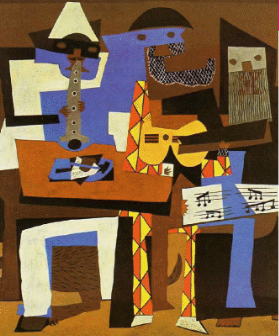Cubism
Cubism was an innovative art movement pioneered by Pablo Picasso and Georges Braque. In Cubism, artists began to look at subjects in new ways in an effort to depict three dimensions on a flat canvas. They would break up the subject into many different shapes and then repaint it from different angles. Cubism paved the way for many different modern movements of art in the 20th century. The movement started in 1908 and lasted through the 1920s. There were two main types of Cubism.
Analytical Cubism: The first stage of the Cubism movement was called Analytical Cubism. In this style, artists would study (or analyse) the subject and break it up into different blocks. They would look at the blocks from different angles. Then they would reconstruct the subject, painting the blocks from various viewpoints.
Synthetic Cubism: The second stage of Cubism introduced the idea of adding in other materials in a collage. Artists would use coloured paper, newspapers, and other materials to represent the different blocks of the subject. This stage also introduced brighter colours and a lighter mood to the art. Let’s take a look at some of the best examples of cubism.
Violin and Candlestick by Georges Braque: This is an early example of Analytical Cubism. In the painting, you can see the broken-up pieces of the violin and the candlestick. Many different angles and blocks of the objects are presented to the viewer. Braque said that this style allowed the viewer to "get closer to the object."
Three Musicians by Pablo Picasso: This painting by Pablo Picasso was one of his later works in Cubism and is an example of Synthetic Cubism. Although it looks like the picture is made out of cut-up pieces of coloured paper, it is actually a painting. In the painting, it is difficult to tell where one musician ends and the next begins. This could represent the harmony of the music as the musicians play together.
Portrait of Picasso by Juan Gris: Cubism was also used to paint portraits. In this example of Analytical Cubism, Juan Gris pays tribute to the inventor of Cubism Pablo Picasso. Like many early Cubism paintings, this painting uses cool blues and light browns for colours. The lines between the different blocks are well defined, but Picasso's facial features can still be recognized.

